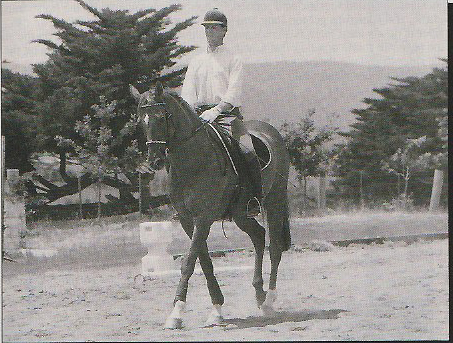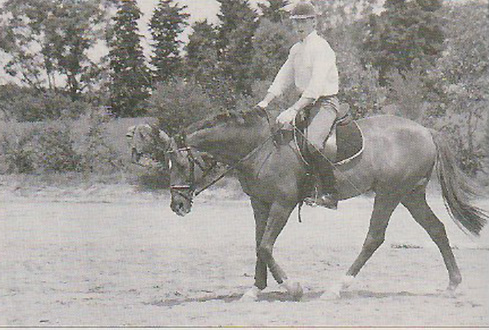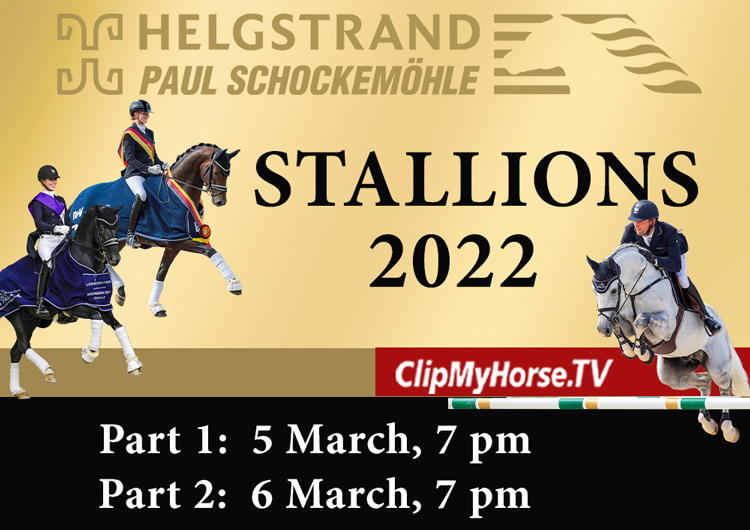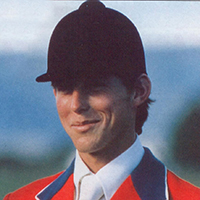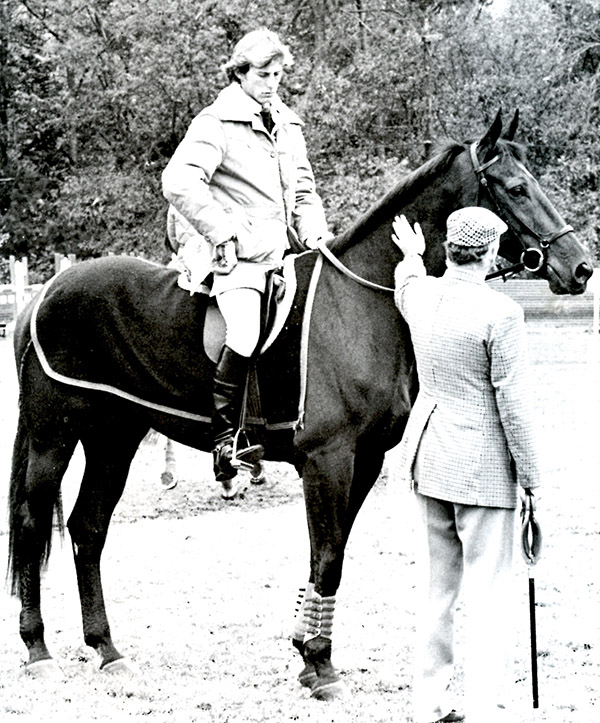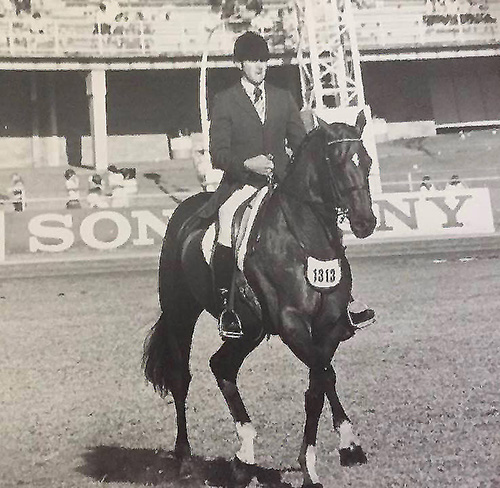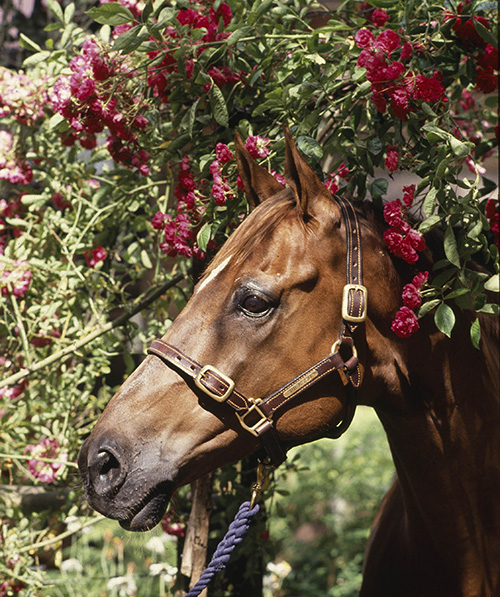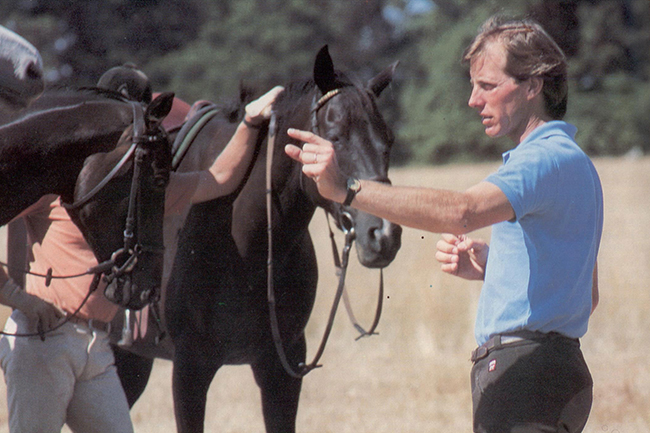
Christopher Hector reports on a clinic with Tad Coffin
Tad Coffin’s dressage clinics took the form of two one day sessions with a rest day in between. After the challenge of the first day, my horse, Fad, and I were looking forward to the challenge of the second.
Once again, we started with theory, and a warning from Tad:
“First I’d like to talk about expectations. The good news is that I think I’ve done some productive work with the horses I’ve ridden, the bad news is that you can’t expect them to go straight on from there, and keep improving at the same rate. Horse are just not predictable.”
Tad riding the wonderful Picasso, alias Fad
“I’ve ridden two horses and identified where I think their resistances are, now the onus is on me to counter those resistances, and for you the riders to try different techniques, and that whole process is fraught with dangers.”
story continues below the advertisement
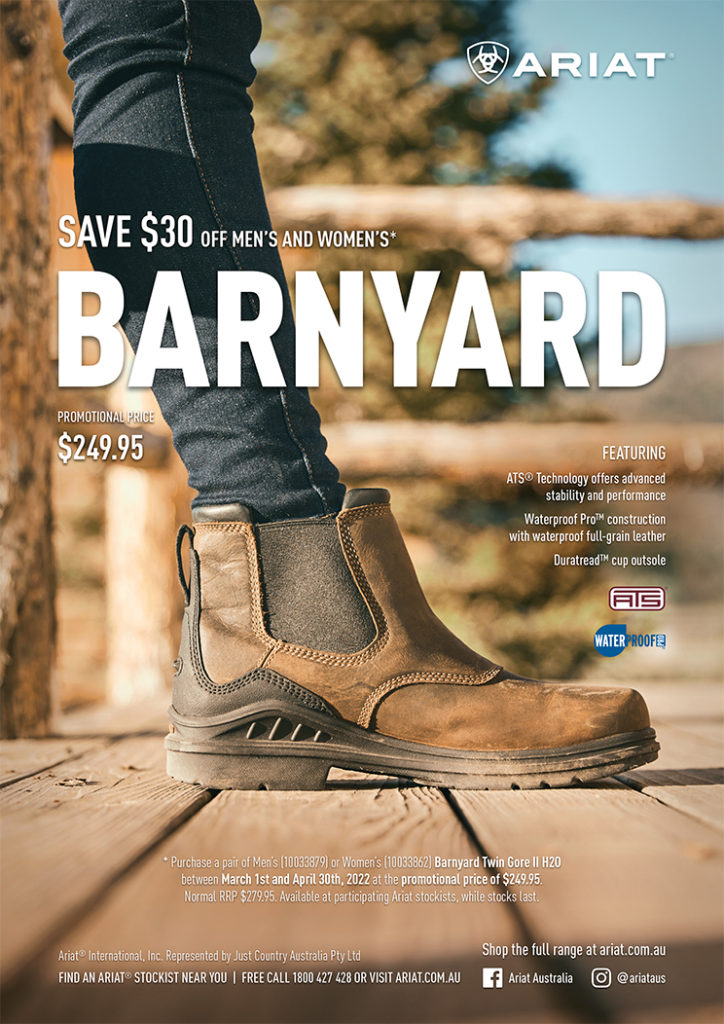
“This morning I would like to talk about long and low. I feel there are some misconceptions about this exercise. Long and low is an exercise used particularly – not exclusively – by German trainers. It seems to be an obligatory exercise in the first five to ten minutes of every riding session. As in all approaches to riding, the best riders understand the value of an exercise is how it is done.”
“The top German trainers do it very successfully, particularly with the heavy necked German horses that need to be ‘arranged’. The less expert German trainers use the exercise because it is what they have been taught, it’s part of the standard routine. Unfortunately the exercise tends to lose a lot in the translation down the ladder.”
“I’ve had two very capable instructors. One was a proponent of long and low, but he was an extremely talented rider who always made the horse longer from the withers to the nose, not from the withers to the hocks. The other instructor stayed away from that exercise because he believed that it required such sophisticated riding that it was better not to take the risk of doing it badly.”
“It is an exercise I like to use occasionally. It’s very good when you think the horse is on the bit to ask the horse to lower its neck – it’s a test to see that I can put the horse anywhere I want. Müesler talked of the horse being rein obedient at all times, so you could put the horse higher or lower as you wished. Long and low is a very good way of testing that the horse is rein obedient, and for that reason I don’t believe that the place for the exercise is always at the beginning or end of the session. If I am going to perform a very collected exercise, then I will sometimes ride very long and low for a few moments before and after, the natural reaction of the horse is to stretch after collection. It’s an automatic rebound, muscles in a state of tension need to be stretched. I suggest you read Udo Burger’s book, The Way of Perfect Horsemanship, and look for the chapter on Biomechanics.”
“This is one of the real problems of the long and low exercise. It requires the use of a seat more in the realm of the expert than the novice rider. Once the rider tries to lower the horse’s head, he becomes obsessed with head carriage. All the rider’s focus is on the hands with the loss of any sense of pushing the horse to the bit and creating flexion through driving.”
“It is so easy for the rider to become impatient and start bit wiggling – the horse drops his nose and everyone feels that they have succeeded. NO! When the horse yields he must immediately be asked to seek the rider’s hand. That moment of yielding is the moment of the greatest danger because that is the moment at which the horse can learn to drop the bit.”
“The more we tend to look down to watch that the horse’s head is going down, the more our shoulders come forward and the more our hips go back, and the more weight we put on the horse’s back, and the less he is able to stretch. One of the real difficulties of trying to ride the long and low exercise is to develop the ability for the rider to allow his arms to get longer and stretch with the horse, without the torso coming forward, or the hips going back.”
“One way to recognize when long and low is done well, is the relationship between the rider and the horse’s back. If the rider is well forward in the saddle and not perched over the withers on his knees, if the rider is coming down in a good solid way meeting the horse’s back, that is a good signature to work being done well in that frame.”
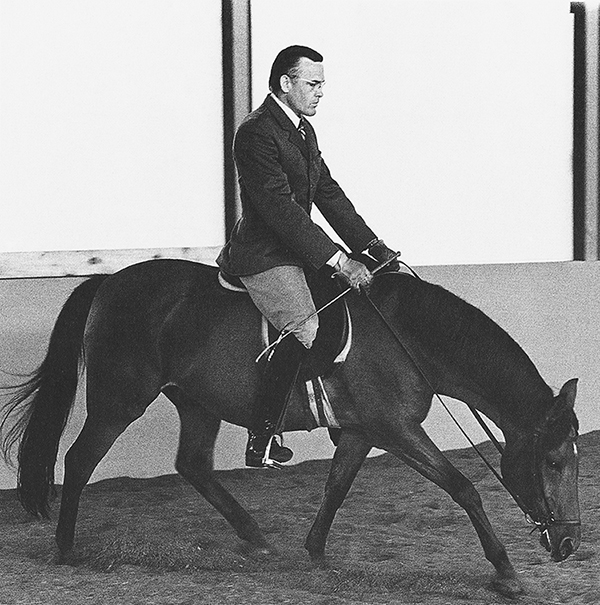
“Look at the photo of Erik Hebermann in his book, The Dressage Formula. The horse is very low, but the rider is very solid in the saddle, and it is very evident that the horse’s back is up. The horse’s nose is in front of the vertical, stretching as much out as down. The horse is really stretching down from the wither, seeking the contact.”
story continues below the advertisement
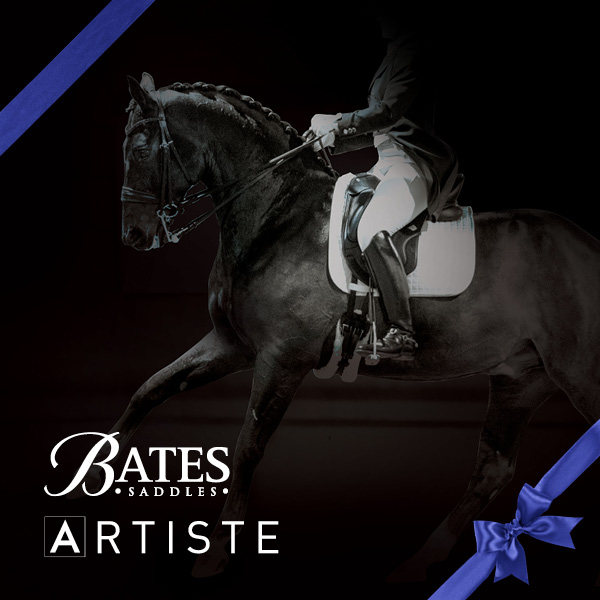
“The way we get to develop the horse’s back is by gaining manipulative control of the horse’s neck, and the only way we can do that is with the mouth. Ask the horse to give to one side, and then drive the horse forward to seek the bit.”
“That way we teach the horse to go longer, seeking the contact, and we develop the horse’s back. And for that, you must have a good saddle to make it feel good for the horse, and the rider must use his seat to ask the horse’s hind legs to bend more, to lower the croup. You can ride at 100 miles an hour, sitting on the cantle of an ill-fitting saddle and the horse’s back still won’t come up. The rider must use his legs to cause the pelvis of the horse to rotate, that brings the whole frame of the horse to move under his own body – then the back comes up.”
“That is one of the reasons I like leg yielding. The horse can’t stretch the inside hind leg under him, unless he stretches the muscles in his back. If you sit straight then leg yielding can be a pretty good way of manipulating the back of the horse to develop the correct carriage.”
“For the rider to have a good seat, the length of the stirrup leathers is crucial. The best place for the rider to be is right behind the horse’s withers, the rider’s pelvis must be pulled forward and rotated up a little. If the stirrups get too long and the rider is on his toes, there is a tendency for the pelvis to rotate down in front , and for the rider to slide to the back of the saddle, putting more weight into the horse’s back and causing it to drop down.”
story continues below the advertisement
It was question time, and my question, about why Tad had concentrated on my horse’s hollow side rather than the stiff side, was probably a bit unfair:
“There really is no more complicated subject than the straightening of the horse. I invite you to read Mary Wanless’Ride with your mind which probably shows more understanding of the subject than any other book.”
“As you know, the horse has two sides – stiff and hollow. The strategy is not to work on one side or the other. We work on both sides at the same time, regardless of direction. Each side has its own characteristics which when dealt with will help the other side.”
“Your horse is very lazy on the left, hollow side. One, he does not like you to sit with your left hip forward, and your weight on the left hip bone, so it is hard to make him follow the pattern you want him to ride.”
“Two, he doesn’t want to make contact with your left leg, or contact with the left rein. The horse would rather have contact with the rider than not, providing the rider can make a very good case for having that contact. Fashion your influence so the horse seeks the contact, and suddenly all sorts of nice things happen – automatically the horse must give on the other side. Often we can achieve a much better result on the stiff side by improving this seeking on the hollow side, particularly with a lazy horse.”
“Usually, I will start work on a tense horse on the first day, on the stiff side, and try to achieve relaxation. On the second day, when the horse is more relaxed, I would work on the hollow side, trying to improve the contact. To get the horse to seek on the hollow side is as powerful an exercise as to get him to give o the stiff side.”
“All horses learn to defend themselves against straightening, they can use lateral exercises to escape. If you go to ride a straightening exercise, like shoulder in, and the horse immediately shoots its hindquarters out away from the inside leg, then you know this is a defence the horse has leant from his previous rider. Horses are a moving target when it comes to straightening them. If you mount a predictable defence, the horse will quickly learn a counter strategy. Forget shoulder in for the moment, go to haunches in, and then come back to shoulder in. There are so many good exercises and we must use them.”
“The rider must think about both sides of his or her body, and must focus on both sides of the horse. To focus on both sides is a major part of straightening. If you really learn to control a horse laterally, then longitudinal control – collection – is easy.”
“The number of riders who can really make a horse straight is about 1%. It requires discipline and a degree of ambidextrousness. It serves rider well to do exercises on the ground to make themselves straight, and to make themselves less one sided. Again, I suggest you read Mary Wanless on asymmetry.”
story continues below the advertisement
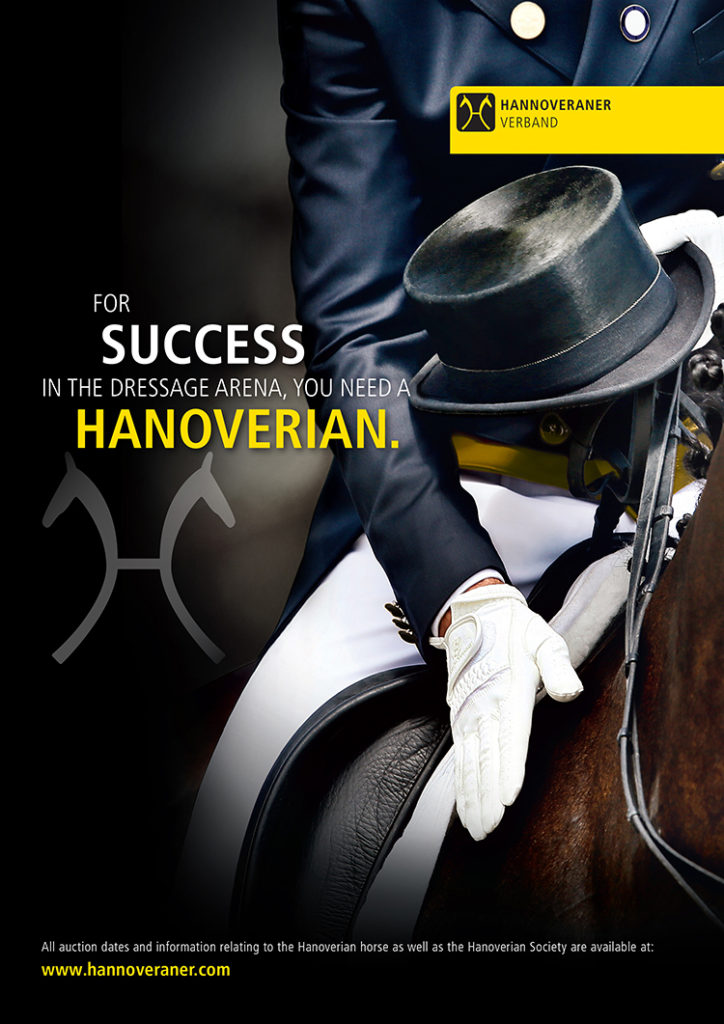
Theory session finished it was time to get moving again on the working arena, but as is always the case with Tad, it’s hard to stop yourself whipping out the notebook to catch pearls like...
“I feel that riders should use a whip and resist the temptation to pump with the body or nag with the legs. Use the whip when you feel a tendency for your heel to come up. Reward the horse the moment it yields, make sure there is a momentary cessation of the driving influence.”
Or when a rider complains even when I concentrate on my hands, I don’t have as much control as I would like – the reply; “Welcome to the club, it’s called manual dexterity.”
“There are three things you should know about your hands. One, the horse should love them. Two, contact should be equal. Three, the horse should never lean on them.”
That really was the lesson of the day for me. Don’t pull on your left hand Chris. DON’T PULL ON YOUR LEFT HAND CHRIS. DON’T PULL ON YOUR LEFT HAND CHRIS. DON’T PULL ON YOUR LEFT HAND CHRIS!!!
It rings in my ears even now as I try at home to re-create the level of concentration and focussed attention that Tad Coffin seems to find it so easy to inspire in the rider. Tad Coffin really is one of the world’s great masters of the art of teaching riding – and good horsemanship…
COFFIN, TAD
Born 1955
Tad (really Edmund Sloane) Coffin grew up on Long Island.
As a keen young horseman, Tad became one of the beneficiaries of the appointment of Jack le Goff in 1970 as coach of the USET Three Day Eventing team. Jack selected a group of young unproven riders to work at the USET headquarters at Gladstone.
In 1975, after the cancellation of Badminton, due to rain, Ledyard Farm CCI became the most important international event of the year, and young Tad Coffin, who had spent two years with Le Goff, and Bally Cor finished 4th. Tad and Bally Cor were selected in the team for the Pan American Games later that year, and took home individual gold, again with Bally Cor.
At the Montreal Olympic Games, the following year, the Americans again took home the team gold, and Tad was once again individual gold medallist – at the age of 21.
Tad became a much sought after coach, before taking up a new trade – saddle maker, and it is no surprise that he approaches the business of producing the perfect saddle with the same intensity he gave to his riding and coaching career.
And for our Australian readers – not forgetting Fad – here he is as a show hack with Roy Davis, and his retirement picture



